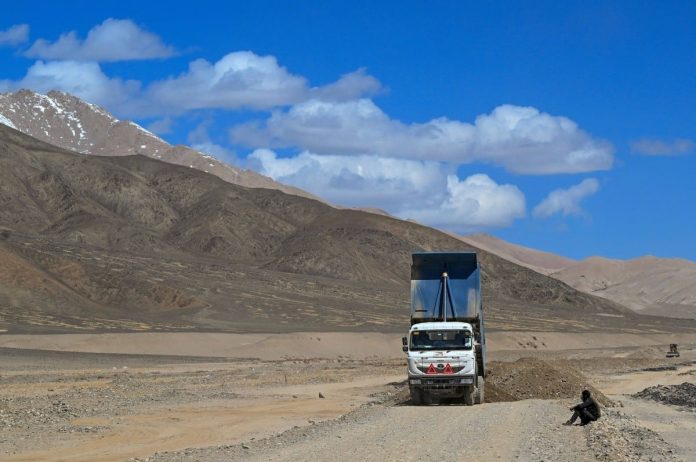India has accelerated its plan to boost infrastructure and connectivity in the volatile Ladakh region, a move seen as countering China’s rapid development along the disputed border.
The latest action centres on the third phase of the strategic India-China Border Project (ICBR) in eastern Ladakh, with observers saying the aim is to boost road networks and enable quicker movement of Indian troops along the Line of Actual Control (LAC) to counter China.
According to media reports, the Border Roads Organisation, with the Central Public Works Department and the National Projects Construction Corporation, has begun the third phase of the ICBR project.
M.S. Prathibha, an associate fellow at the Institute for Defence Studies and Analyses, told This Week in Asia that India had been increasingly concerned about the rapid expansion of infrastructural and dual-use capabilities that would help Chinese troops be deployed faster in the border areas.
“India’s vulnerability in even maintaining a strategically defensive posture has been challenging due to the gaps in logistics and troops mobility,” Prathiba said, adding that the ICBR projects were aimed at plugging such vulnerabilities should India face any military action from the Chinese side.
“It is to improve the overall capabilities of the Indian military that has been long overdue, especially involving logistics,” she added.
India’s border with China spans 3,488km across Ladakh, Arunachal Pradesh, Himachal Pradesh, Uttarakhand and Sikkim.
In the third phase of the ICBR, out of 37 roads five new ones have been identified to be constructed in eastern Ladakh while nearly 70 per cent of the roads will be built in the state of Arunachal Pradesh.
Under the first phase, 73 roads of nearly 4000km in length were identified as strategic in the states of Ladakh, Himachal Pradesh, Uttarakhand, Sikkim and Arunachal Pradesh.
In phase two, the construction of 104 roads of more than 6,700km long was approved in the 2020-21 financial budget. In Arunachal Pradesh under the same phase, apart from building 57 roads, the Indian government is also building 32 helipads, 47 border outposts and 12 staging camps for the Indo-Tibetan Border Police.
According to Atul Kumar, a fellow in Strategic Studies Programme at Observer Research Foundation, a think tank based in New Delhi, ICBR aims to develop crucial border roads and provide connectivity along the LAC.
“Initially, progress was slow but gained momentum after the Depsang, Doklam, Galwan and Yangtse incidents. The urgency was further driven by China’s massive infrastructure build-up on the Tibetan side of the LAC, which includes numerous roads, rail connections, and aviation facilities. Strategically placed xiaokang [well-off villages] sustain this build-up, with the latest one coming up in Demchok,” Kumar said.
India and China have been in a military stand-off at the border since the 2020 Galwan Valley clash, which killed 20 Indian soldiers and four Chinese troops.
In June 2017, a two-month stand-off occurred between Indian troops and Chinese People’s Liberation Army in Tibet’s Doklam region after China attempted to build a road near a tri-junction border.
Another face-off in January 2021 near Sikkim resulted in injuries on both sides, while in December 2022, the two armies clashed again at Yangtse near Tawang in Arunachal Pradesh.
Indian External Affairs Minister S. Jaishankar acknowledged on Monday that India-China relations were “not doing very well” at the moment.
Kumar said India had followed up on the first ICBR phase with its second and third phases, resulting in visible and substantial gains.
“Local connectivity, last-mile feeder roads, and connections from LAC outposts to the hinterland have improved, facilitating the provision of logistics, medical services and social goods,” Kumar said, adding that the construction of new tunnels was transforming the northern mountains.
Prime Minister Narendra Modi recently inaugurated the 4.1km-long Shinku La tunnel, part of the ICBR initiative in Himachal Pradesh. The tunnel will ensure all-weather connectivity between Manali and Leh, improving the movement of armed forces and equipment.
In March this year, Modi opened the strategically significant Sela tunnel in Arunachal Pradesh, sparking a war of words between Beijing and Delhi.
Time to get rail
Kumar, however, said a paradigm shift in Indian border connectivity required rail infrastructure.
“Ladakh and Arunachal Pradesh’s northern regions urgently need railways, attracting tourists to the less-explored hills, significantly boosting the local economy, and providing the armed forces with easier access to remote outposts and crucial military locations,” he said.
The government has more than doubled the pace of road construction since 2017 and also stepped up building of villages along the border with China, including in key states such as Arunachal Pradesh and Ladakh.
Defence expert Rakesh Sharma told This Week in Asia that the Chinese incursions in 2020 had changed the entire geometry of the borders.
“The Chinese have worked on their infrastructure at a feverish pace – on highways, extending runways, creating heliports, and military habitat. These are also in Aksai Chin, creating a serious threatening posture. Providing impetus to infrastructure development in India was a natural response,” said Sharma, a distinguished fellow at Delhi-based think tank Centre for Land Warfare Studies.
Since 2019, China has been building villages along the LAC with more than 600 xiaokang along India’s borders with the Tibet autonomous region.
Sharma said India had dovetailed with other infrastructural development companies in the civil sector for projects such as the Zojila tunnel connecting Srinagar and Kargil, and an alternative road to Tawang to boost year-round connectivity.
B.R. Deepak, a professor of Chinese and China Studies at Jawaharlal Nehru University, said while it was good that India had picked up the pace on border infrastructure development, the government should also prioritise railway connectivity, particularly in the eastern sector.
“ICBR projects are important for revamping our border infrastructure. A survey on railway connectivity to the LAC was done, but so far, no action plan has been implemented on the ground,” said Deepak, adding that India had a lot to do to match China’s modernisation.
Deepak noted there could be more friction in eastern Ladakh given the developments in the area.
“The latest developments like construction of roads, and especially the tunnels, will facilitate the connectivity for the transporting and mobilising of troops. Seeing these developments, China could open up more friction points in eastern Ladakh,” Deepak said, adding that with the Shinku La tunnel, India now had access to Ladakh from Himachal Pradesh via two routes, in addition to the traditional Srinagar route.









































